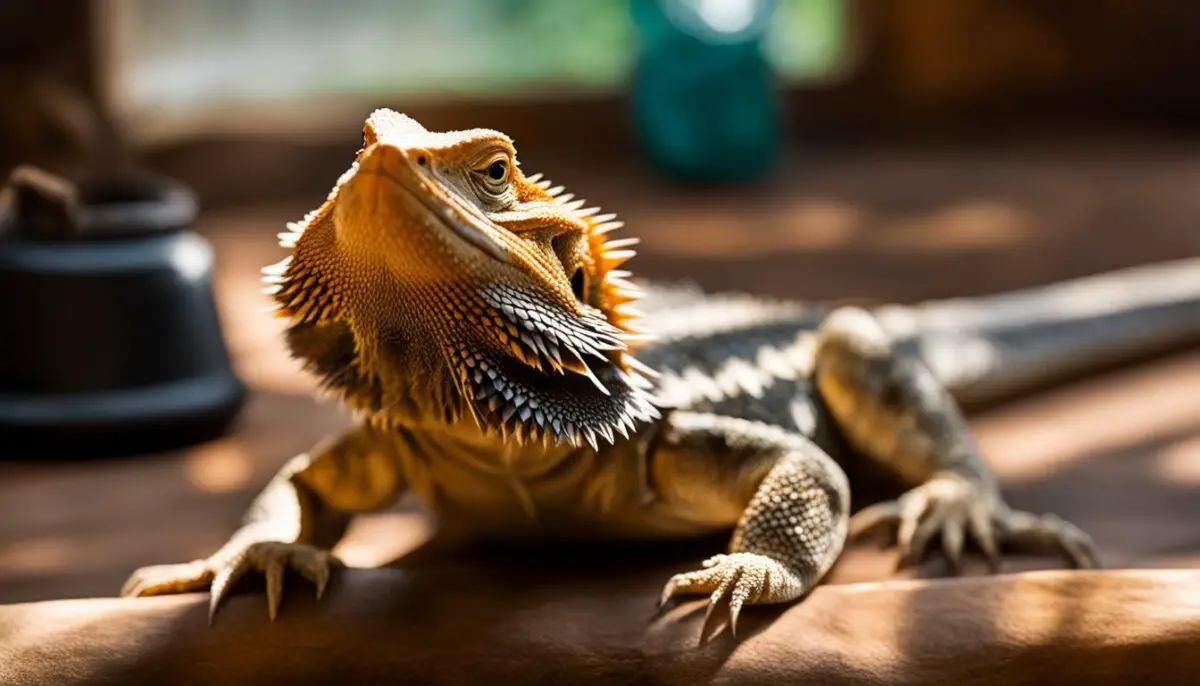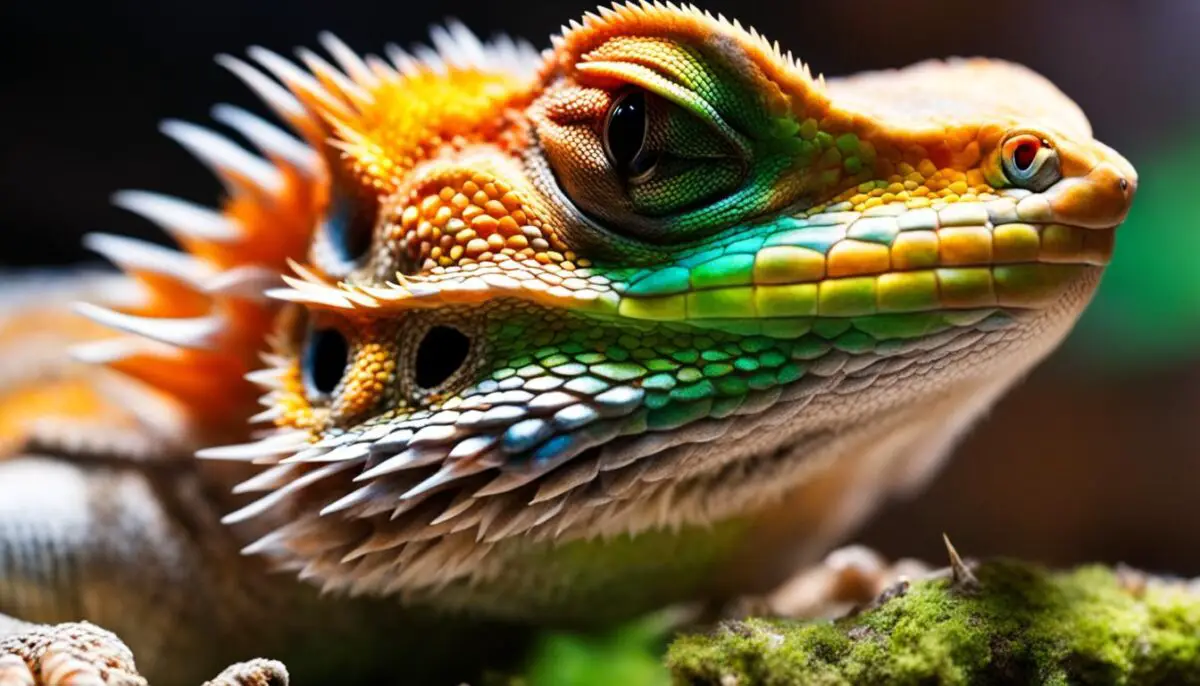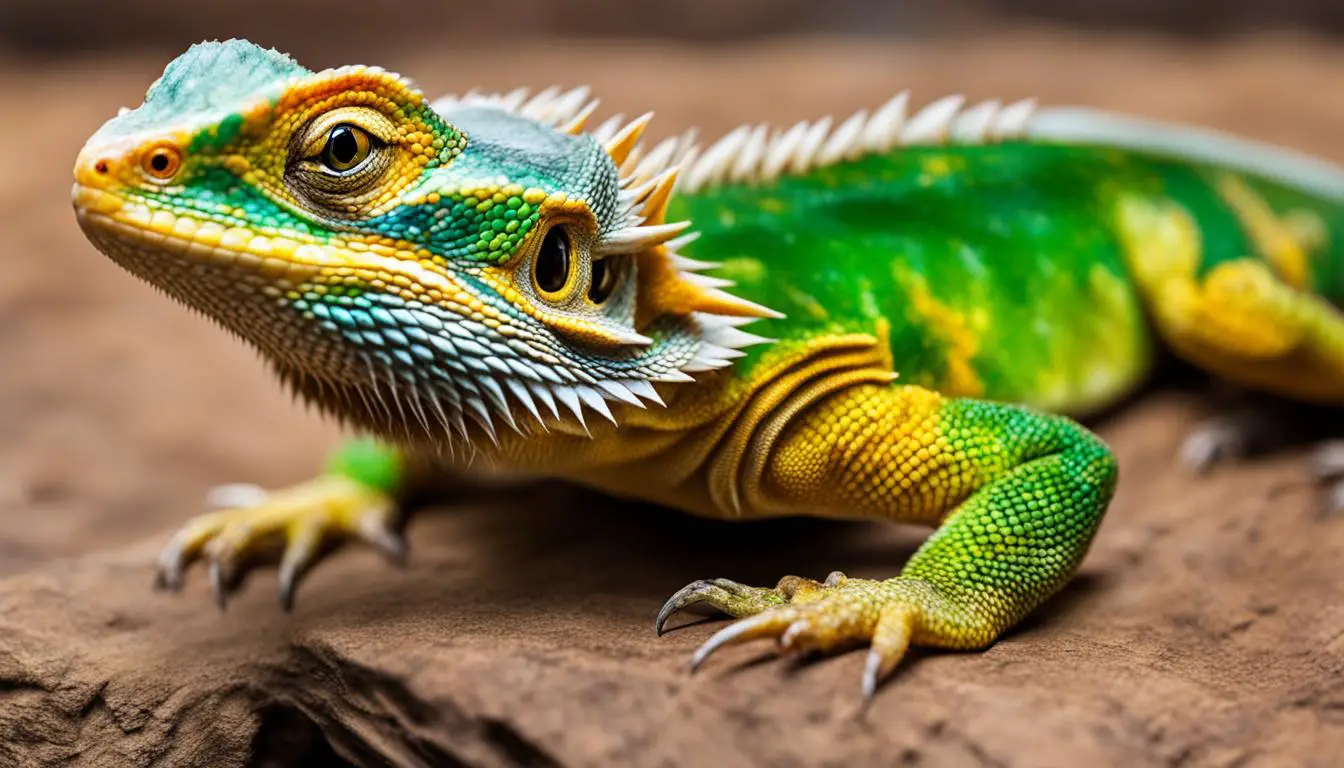Are you considering getting a pet? How about welcoming a 12-inch bearded dragon into your home? These fascinating lizards, also known as “beardies,” originate from Australia and make for unique and captivating companions. If you’re caring for an 11-month-old bearded dragon, it’s important to provide the right care and attention to ensure their well-being. Let’s explore the behavior, habitat setup, feeding schedule, and health considerations for your 11-month-old bearded dragon.
Key Takeaways:
- Bearded dragons are moderately sized lizards, reaching 16 to 24 inches in adulthood.
- Proper habitat setup includes a spacious tank, rocks, branches, and hiding spots.
- Feeding an 11-month-old bearded dragon requires a balanced diet of insects and vegetables.
- Regular vet check-ups and attention to behavior and hygiene are crucial for their health and wellness.
- Observing and understanding their unique behaviors will help you bond with your pet.
Habitat Setup for Your Bearded Dragon
Creating the perfect habitat for your bearded dragon is essential to ensure their overall health and happiness. A well-designed tank setup will provide them with a comfortable and stimulating environment that mimics their natural habitat.
To start, choose a tank with a capacity of 55 to 75 gallons. This size will provide enough space for your bearded dragon to move around and explore. Make sure to have a secure screen top to prevent escapes while still allowing for proper ventilation.
When setting up the tank, include various elements to cater to your bearded dragon’s needs. Place sturdy rocks, half logs, and branches for climbing and basking. These structures will provide opportunities for exercise and stimulation. Additionally, provide hiding spots like hollow logs or caves where your bearded dragon can retreat when they need privacy or feel threatened.
| Temperature | UV Lighting | Humidity | Substrate |
|---|---|---|---|
| Maintain a temperature gradient ranging from 80 to 105 degrees Fahrenheit. This allows your bearded dragon to thermoregulate and find the ideal temperature for their comfort. | Install UVB lighting to provide your bearded dragon with essential ultraviolet rays necessary for proper calcium absorption. Aim for 10-12 hours of exposure per day. | Keep the humidity level between 35% and 40%. This range will prevent respiratory issues without creating an overly damp environment. | Choose a suitable substrate for the enclosure. Options include reptile carpet, newspaper, or tiles. Avoid loose substrates like sand or gravel, as they can pose risks if ingested. |
Remember to regularly clean the tank to maintain a hygienic environment for your bearded dragon. Remove any waste and replace soiled substrate promptly. Additionally, provide fresh water in a shallow dish for your bearded dragon to drink and soak in.
By creating a well-designed habitat, you will provide your bearded dragon with the ideal living conditions for their health and well-being.
Feeding Schedule for Your 11-Month-Old Bearded Dragon
Your 11-month-old bearded dragon requires a well-balanced diet to support their growth and overall health. Establishing a feeding schedule is essential to ensure they receive the necessary nutrients. Here’s a breakdown of their feeding requirements:
- Insects: Your bearded dragon should be fed a variety of appropriately sized insects, such as crickets, waxworms, and superworms. Offer them insects that are no larger than the width between their eyes to prevent choking hazards.
- Vegetables: In addition to insects, include a variety of leafy greens and other vegetables in their diet. Some suitable options include kale, collard greens, mustard greens, squash, and bell peppers.
- Feeding Frequency: Baby bearded dragons often require three feedings per day, while adults can be fed once every 24 hours. Adjust the quantity of food based on their appetite and size.
- Supplements: Dusting insects with calcium and vitamin D supplements is crucial to prevent metabolic bone disease. Consult with a veterinarian to determine the appropriate supplement dosage for your bearded dragon.
Ensure your bearded dragon has access to fresh water at all times. Offer the vegetables and insects separately to promote a varied diet and to encourage natural foraging behaviors. Remember to monitor their weight and adjust their feeding schedule accordingly to maintain a healthy body condition.

Table: Sample Feeding Schedule for an 11-Month-Old Bearded Dragon
| Time | Meal | Quantity |
|---|---|---|
| Morning | Vegetables | Offer a variety of leafy greens and vegetables |
| Afternoon | Insects | 6-8 appropriately sized insects |
| Evening | Insects | 6-8 appropriately sized insects |
Note: This is a general feeding schedule and can be adjusted based on your bearded dragon’s specific needs and appetite. Observe their behavior and consult with a veterinarian for personalized feeding recommendations.
Health and Wellness for Your 11-Month-Old Bearded Dragon
Caring for the health and wellness of your 11-month-old bearded dragon is of utmost importance. These reptiles are prone to several common health issues that can affect their overall well-being. By understanding the potential risks and taking preventive measures, you can help ensure that your bearded dragon stays healthy and happy.
One common health issue in bearded dragons is metabolic bone disease. This condition occurs when there is an imbalance in the calcium-to-phosphorus ratio, leading to weak and fractured bones. To prevent this, it’s crucial to provide your bearded dragon with a well-balanced diet that includes foods rich in calcium, such as leafy greens and calcium-dusted insects.
Respiratory infections are another concern for bearded dragons. Wheezing, excess mucus, and labored breathing are signs of respiratory issues. To prevent these infections, maintain a clean and hygienic habitat, and avoid exposing your bearded dragon to cold drafts or extreme temperature fluctuations.
Digestive impaction can also occur in bearded dragons, especially if they consume insects that are too large or indigestible. This can lead to blockages in their digestive tract, causing discomfort and potentially life-threatening complications. To prevent impaction, ensure that the insects you feed your bearded dragon are appropriately sized and easily digestible.
| Common Health Issues in Bearded Dragons | Symptoms | Prevention |
|---|---|---|
| Metabolic Bone Disease | Weak and fractured bones | Provide a balanced diet rich in calcium |
| Respiratory Infections | Wheezing, excess mucus, labored breathing | Maintain a clean and hygienic habitat |
| Digestive Impaction | Blockages in the digestive tract | Feed appropriately sized and digestible insects |
Regular veterinary check-ups are essential in monitoring your bearded dragon’s health and catching any potential issues early on. If you notice any changes in behavior, appetite, or physical appearance, consult with a reptile veterinarian to ensure proper diagnosis and treatment.
By prioritizing the health and wellness of your 11-month-old bearded dragon, you can provide them with the best possible care and enjoy a long and fulfilling companionship.
Behavior of 11-Month-Old Bearded Dragons
At 11 months old, bearded dragons exhibit a range of fascinating behaviors that make them unique and interesting pets. Understanding their behavior will help you bond with your pet and ensure their overall well-being. Here are some key behaviors to observe and grooming tips to keep in mind:
Basking:
Bearded dragons require a basking spot in their habitat where they can raise their body temperature. This behavior is important for their digestion and overall health. Ensure that your dragon has a heat source and a designated basking area with a temperature gradient, allowing them to regulate their body temperature.
Head-bobbing:
Head-bobbing is a common behavior in bearded dragons, especially when they are trying to communicate or establish dominance. It is their way of signaling their presence or expressing their feelings. While head-bobbing is generally harmless, it’s essential to pay attention to any changes in behavior or excessive head-bobbing, as it could be a sign of stress or illness.
Arm-waving:
Bearded dragons may exhibit arm-waving as a social behavior or a response to their surroundings. This behavior often happens during interactions with other dragons or their owners. It can be a sign of submission or a display of dominance. Arm-waving is a fascinating behavior to observe, but it’s crucial to ensure that your dragon feels secure and comfortable in its environment.
Glass surfing:
Glass surfing, also known as “glass dancing,” is when a bearded dragon repeatedly runs or scratches against the glass walls of its enclosure. This behavior can indicate stress, boredom, or a desire for more stimulation. Providing an enriching environment with plenty of climbing opportunities, hiding spots, and toys can help alleviate glass surfing behaviors.
Grooming your bearded dragon is also an important aspect of their care. Regular baths can help keep their skin clean and hydrated, while nail trims prevent overgrowth and discomfort. Remember to use reptile-safe products and techniques when grooming your dragon. By understanding and observing their behavior, and providing appropriate grooming care, you can ensure a happy and healthy life for your 11-month-old bearded dragon.
| Behavior | Description |
|---|---|
| Basking | Bearded dragons require a basking spot in their habitat to regulate their body temperature. |
| Head-bobbing | Head-bobbing is a common behavior used to communicate or establish dominance. |
| Arm-waving | Arm-waving can be a social behavior or a response to their surroundings, indicating submission or dominance. |
| Glass surfing | Glass surfing is when a bearded dragon repeatedly runs or scratches against the enclosure walls, often a sign of stress or boredom. |
Selecting and Caring for Your Bearded Dragon
Choosing the right bearded dragon is the first step in providing proper care for your 11-month-old pet. Look for an active dragon with healthy-looking skin, avoiding any signs of swelling, discharge, or discoloration. A dragon with a good appetite and solid droppings is a positive sign of overall health. By selecting a healthy bearded dragon, you set the foundation for a happy and thriving reptile companion.
Once you bring your bearded dragon home, it’s important to provide the right environment and care. Creating a suitable habitat is crucial, including a spacious tank with proper temperatures and UV lighting. Regular feeding of a balanced diet, consisting of insects and vegetables, is essential for their growth and well-being. Additionally, monitoring their health and behavior, and seeking veterinary care when needed, will ensure they stay healthy and happy.
Bearded Dragon Care Checklist:
- Choose an active bearded dragon with healthy skin
- Set up a proper habitat with the right tank size, temperature, and lighting
- Feed a balanced diet of insects and vegetables, providing necessary supplements
- Monitor their health and behavior, seeking veterinary care as needed
By following these care guidelines, you can provide a loving and nurturing environment for your 11-month-old bearded dragon, ensuring they live a long and fulfilling life as your companion.

Grooming Tips for Bearded Dragons:
- Regularly bathe your bearded dragon to keep their skin clean and hydrated.
- Trim their nails carefully to prevent overgrowth and discomfort.
- Provide a well-ventilated tank with appropriate lighting and heating.
- Include various enrichments such as rocks and branches for climbing.
- Ensure the tank is regularly cleaned and sanitized to maintain a hygienic environment.
By following these grooming tips and creating a perfect environment for your bearded dragon, you can provide them with the care and comfort they need to thrive.
Common Health Issues in Bearded Dragons
Bearded dragons, like any other pets, are susceptible to certain health issues. As an owner of an 11-month-old bearded dragon, it’s important to be aware of these common health problems and take proactive measures to prevent and address them.
One common health issue in bearded dragons is metabolic bone disease (MBD). This condition occurs when there is an imbalance in the calcium-to-phosphorus ratio, resulting in weak and fractured bones. To prevent MBD, it’s essential to provide your bearded dragon with a diet rich in calcium and vitamin D, along with access to proper UV lighting to aid in calcium absorption.
Respiratory infections are another concern for bearded dragons. Wheezing, excess mucus, and labored breathing are signs that your pet may be suffering from a respiratory infection. Maintaining a clean and hygienic enclosure, along with providing appropriate temperature and humidity levels, can help prevent these infections. If you notice any symptoms, it’s crucial to consult with a reptile veterinarian for proper diagnosis and treatment.
“Metabolic bone disease and respiratory infections are common health issues that can affect bearded dragons. Providing a balanced diet, proper UV lighting, and a clean environment are key preventative measures.”

Digestive impaction is another health issue that bearded dragons may experience. This occurs when certain insects, such as mealworms or waxworms, are not properly digested and can cause blockages in the digestive tract. To prevent impaction, it’s important to feed appropriately sized insects and avoid feeding your bearded dragon any hard or large prey items.
Regular vet check-ups are essential in maintaining the overall health of your 11-month-old bearded dragon. A reptile veterinarian can assess your pet’s condition, provide advice on diet and habitat, and address any health concerns. By staying vigilant and addressing common health issues, you can ensure that your bearded dragon lives a happy and healthy life.
| Common Health Issues in Bearded Dragons | Symptoms | Prevention |
|---|---|---|
| Metabolic Bone Disease (MBD) | Weak and fractured bones | Provide a diet rich in calcium and vitamin D, along with UV lighting for proper calcium absorption |
| Respiratory Infections | Wheezing, excess mucus, labored breathing | Maintain a clean and hygienic enclosure, proper temperature, and humidity levels |
| Digestive Impaction | Blockages in the digestive tract | Feed appropriately sized insects and avoid hard or large prey items |
Conclusion
Owning a 12-inch bearded dragon can be a rewarding experience. By providing proper care, including a suitable habitat, balanced diet, and regular health check-ups, you can ensure the well-being of your 11-month-old bearded dragon. Understanding their behavior, grooming them regularly, and creating a comfortable environment will help foster a strong bond between you and your pet. With the right care and attention, your bearded dragon will thrive and bring joy to your home for years to come.
FAQ
What size tank is ideal for an adult bearded dragon?
A 55- to 75-gallon tank with a secure screen top is ideal for a single adult bearded dragon.
What should I include in my bearded dragon’s habitat?
You should include sturdy rocks, half logs, branches for climbing, and hiding spots like hollow logs to make your bearded dragon feel secure.
What temperatures and lighting should I provide for my bearded dragon?
Maintaining temperatures ranging from 80 to 105 degrees Fahrenheit and providing UV lighting are essential for their well-being.
What should I feed my 11-month-old bearded dragon?
You should feed them a combination of appropriately sized insects like crickets, waxworms, and superworms, as well as leafy greens and other vegetables.
How often should I feed my 11-month-old bearded dragon?
Baby bearded dragons often eat three times per day, while adults should be fed at least once every 24 hours.
What are some common health issues in bearded dragons?
Bearded dragons are prone to metabolic bone disease, respiratory infections, and digestive impaction.
How can I prevent health issues in my bearded dragon?
Regular vet check-ups, maintaining a proper diet, and keeping the enclosure clean and hygienic are essential in preventing health issues.
What behaviors can I expect from my 11-month-old bearded dragon?
Some typical behaviors include basking, head-bobbing, arm-waving, and glass surfing.
How do I select a healthy bearded dragon?
Look for an active dragon with healthy-looking skin and avoid ones with swollen joints, discharge around the eyes or nose, discolored skin, or runny droppings.
How can I create a comfortable environment for my bearded dragon?
You can create a comfortable environment by providing appropriate temperatures, UV lighting, climbing opportunities, and hiding spots.


